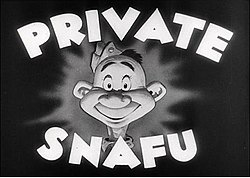| Three Brothers | |
|---|---|
 | |
| Directed by | Friz Freleng |
| Written by | Dr. Seuss |
| Produced by | Leon Schlesinger |
| Starring | Mel Blanc |
Release date |
|
Running time | 5 minutes |
| Country | United States |
| Language | English |
Three Brothers is part of the Private Snafu series of animated shorts produced by Warner Bros. during World War II. Screened for troops in September 1944, the cartoon was directed by Friz Freleng and features the familiar voice of Mel Blanc. [1]
Contents
A series of cartoons for the Navy featuring Private Snafu's brother "Seaman Tarfu" were planned, but the war came to a close and the project never materialized, save for a single cartoon entitled Private Snafu Presents Seaman Tarfu in the Navy. [2]